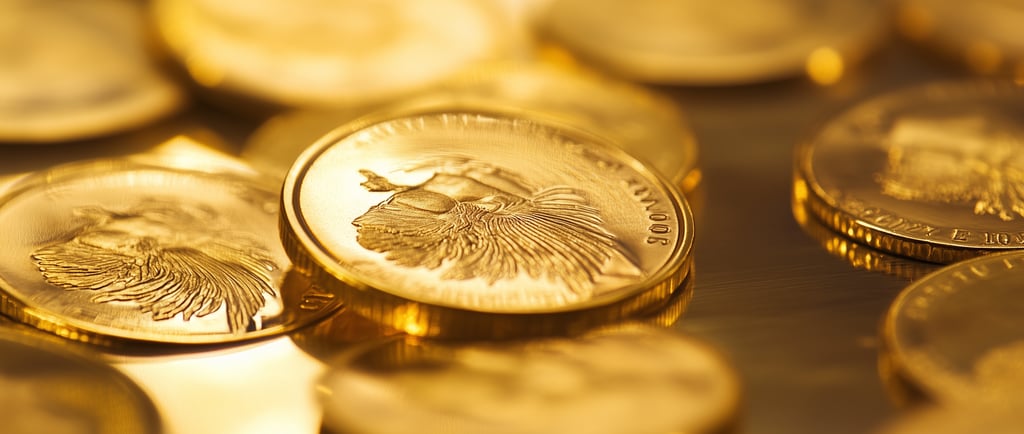

Disclosure: Clicking on links may earn me commission at no additional cost to you. Thank you for reading!
Discover the current price of 1 oz of gold, understand the market influences, and explore historical gold value trends.
How Much is 1 oz of Gold?
Disclaimer: This website and its content are for informational purposes only and is not financial advice.
As of September 20th, 2025. The price of gold has hovered around $3,685 per ounce. However, the live price will be on the live price tracker located in this blog post.
The Current Price of 1 Ounce of Gold and Market Analysis
As of September 20th, 2025, the live gold spot price for 1 ounce of gold in U.S. dollars (USD) is approximately $3,685.
This figure, known as the spot price, is the benchmark market price at which one troy ounce of pure gold can be bought or sold for immediate delivery. It serves as the foundation for pricing virtually all gold products, from bullion bars to collectible coins, though the final purchase price for physical gold will typically include a slight premium for fabrication, distribution, and dealer costs.
Why is 1 oz of Gold So High in 2025?
The current price of 1 oz of gold is exceptionally high, nearing all-time record highs, due to a confluence of powerful economic and geopolitical forces:
Geopolitical Uncertainty and Safe-Haven Demand: Ongoing geopolitical tensions globally are a significant driver. When international conflicts or political instability rise, investors consistently turn to gold as a safe-haven asset, prompting a surge in demand for gold and pushing its price higher. This is a classic response to risk.
Anticipation of Monetary Easing (Lower Interest Rates): Expectations of the U.S. Federal Reserve resuming an interest rate cutting cycle have provided a substantial tailwind. When interest rates are low, or expected to fall, assets that don't pay interest, like gold, become more attractive compared to bonds or savings accounts. The prospect of multiple rate cuts this year has driven strong year-to-date gains in the gold price.
Weakening U.S. Dollar: Gold is priced globally in U.S. dollars. Typically, a weaker dollar makes 1 oz of gold cheaper for buyers using other currencies, which increases demand and helps drive the dollar-denominated price higher. While the dollar's movement can be complex, its recent performance, coupled with Fed policy expectations, has been supportive of a higher gold price.
Robust Central Bank Demand: Central banks worldwide have been engaging in significant gold purchasing to diversify their monetary reserves away from paper currencies. This institutional-level buying provides a massive, consistent floor of demand for 1 oz of gold and is cited by many analysts as a primary reason the price is holding at such elevated levels.
These forces, safe-haven demand, interest rate expectations, currency weakness, and central bank buying, are currently interacting to keep the price of 1 oz of gold at this premium level.
Gold's History as a Store of Value
Throughout history, gold has held a unique position as a store of value and a symbol of wealth. Its inherent properties, its rarity, its resistance to corrosion, and its malleability, have made it a desirable material for jewelry, currency, and ornamentation across cultures and civilizations.
This historical significance contributes to the ongoing demand for gold, which in turn plays a crucial role in determining how much 1 oz of gold is on any given day. From ancient Egyptian tombs to the modern central bank vault, gold has been a trusted asset because it cannot be created by a government printing press and its supply is inherently limited by what can be mined from the earth.
The fact that the entire volume of gold ever mined would fill only a few Olympic-sized swimming pools underscores its incredible scarcity, solidifying its role as a hedge against the unlimited supply of paper currency.
The Role of Economic Factors in Gold Pricing
In modern financial markets, the price of 1 oz of gold is closely watched as an indicator of economic sentiment and a hedge against inflation and currency fluctuations. It often moves inversely to other major financial indicators, serving as a reliable counter-balance in an investment portfolio.
When economic uncertainty rises, for example, during a recession fear or a credit crunch, investors often turn to gold as a safe-haven asset, increasing demand and potentially driving the price higher. Conversely, during periods of strong economic growth and stability, investors may shift their focus to assets perceived as having higher growth potential, such as stocks, which can sometimes lead to a decrease in the price of 1 oz of gold.
Key Economic Influencers on the Price of 1 oz of Gold:
Interest Rates and Monetary Policy: This is a crucial factor. Gold generally thrives in a low interest rate environment because, unlike bonds or cash, gold offers no yield (interest payments). When rates are low, the opportunity cost of holding gold is also low, making it a more attractive investment. When central banks, like the U.S. Federal Reserve, implement policies to lower rates (easing), the price of 1 oz of gold typically sees upward pressure.
Inflation: Gold is often called the ultimate inflation hedge. Inflation, the erosion of purchasing power over time, means your paper money buys less. Since the supply of gold is constrained, it tends to hold its value in real terms. When inflation expectations are high, demand for 1 oz of gold rises as investors seek protection for their wealth.
The U.S. Dollar: As noted earlier, gold is primarily denominated in U.S. dollars globally. A stronger U.S. dollar means that it takes fewer dollars to buy an ounce of gold, which can put downward pressure on the price. Conversely, a weaker U.S. dollar has the opposite effect, often pushing the price of 1 oz of gold higher. This inverse relationship is one of the most consistent short-term drivers of the gold market.
Updated Sep 20th, 2025
Share this:
Geopolitical Events and Gold's Value
Geopolitical events also exert a considerable influence on the value of gold. Political instability, international conflicts, and changes in government policies can create uncertainty in financial markets, prompting investors to seek the security of gold.
As a result, events on the global stage can have a direct and sometimes significant impact on how much 1 oz of gold will be at any particular moment. For example, the outbreak of conflict, significant trade disputes, or even major elections can trigger sudden spikes in the price of 1 oz of gold as investors rush to liquidate riskier assets for the universally accepted security of the metal.
This flight-to-safety behavior is a predictable response, making gold an excellent portfolio diversifier during times of crisis. Historically, gold has proven its reliability during times when confidence in financial institutions or governments is shaken.
Supply and Demand in the Gold Market
Furthermore, the supply and demand dynamics within the gold market itself are critical determinants of its price. Unlike most industrial commodities, gold has a peculiar supply-demand balance. The total amount of gold ever mined is largely still in existence, meaning above-ground stock (held as jewelry, bullion, or in central banks) dwarfs the annual mining supply.
The amount of new gold being mined annually, while significant, makes up only a fraction of the total supply. Disruptions to this supply due to geopolitical instability in mining regions or environmental regulations can cause upward pressure on the price of 1 oz of gold.
On the demand side, there are four primary sources:
Jewelry: This is historically the largest component of demand, particularly from markets like India and China, where gold holds immense cultural significance.
Investment: This includes the purchase of physical bars and coins (like a 1 oz gold coin or bar), as well as investments in gold-backed Exchange Traded Funds (ETFs) and other financial products. This demand is highly sensitive to the economic and geopolitical factors mentioned above.
Central Banks: As highlighted in the current price analysis, the decisions of central banks regarding their gold reserves are a major factor. Large-scale buying by central banks acts as a stabilizing source of demand, preventing sharp price drops and contributing to a higher baseline price for 1 oz of gold.
Industrial Use: Gold's excellent conductivity and resistance to corrosion make it essential in electronics (like smartphones and computers) and medical devices. This demand is generally small but provides a baseline use for the metal.
All of these factors, mining output, central bank activity, and the demand for gold in various industries, contribute to the overall equilibrium that dictates how much an ounce of gold is.
The Difference Between Spot Price and Purchase Price
When you look up "1 ounce of gold," the price you see, like the $3,685 figure cited earlier, is the Spot Price. This is the wholesale price for a large, standardized quantity of pure gold traded in the global commodities market.
However, when you go to purchase a physical 1 oz gold bar or a 1 oz gold coin, you will always pay a price slightly above the spot price. This difference is called the premium.
Spot Price: The price of one troy ounce of gold available for immediate delivery in the wholesale market.
Premium: The added cost that covers the expense of refining, minting (turning the gold into a coin or bar), distributing, and the dealer's profit margin.
Final Purchase Price: Spot Price + Premium.
Premiums are often higher for smaller products, like a 1 oz gold coin, because the manufacturing cost is proportionally higher than for a large kilogram bar. Rare, collectible coins, known as numismatics, can have very high premiums due to their historical value and scarcity, which is separate from their intrinsic gold content. A true investment in 1 oz of gold as a commodity focuses on bullion with minimal premiums.
A Deeper Understanding of Gold's Price
Understanding these fundamental factors provides a more complete picture than simply knowing the current price. While the live tracker offers an up-to-the-minute figure for how much 1 oz of gold is, appreciating the forces that drive this price allows for a more informed perspective on its value and potential future movements. It transforms the gold price from a random number into a dynamic indicator of global economic health and political tension.
By staying informed about global economic trends, geopolitical developments, and the intricacies of the gold market, you can gain a deeper understanding of the significance behind the daily price of 1 oz of gold. The consistent, overwhelming demand from both institutional and individual investors continues to cement its role as a bedrock asset, a timeless currency that maintains its purchasing power when paper currencies falter.
Subscribe to Newsletter
Get updates on new Gold IRA posts, market news, and more.
By Jordan McCaleb, Precious Metals Investment Researcher


